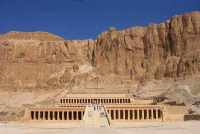KV 64 We know more about this discovery!

During the season of 2011, three edges of an unknown manmade feature appeared at 1.80m to the north of KV 40, on the 25th of January, the first day of the Egyptian revolution. Due to the situation, it was immediately covered with an iron door.
As this structure is so close to KV 40 and as it was impossible to know whether it was just a short unfinished shaft or a real tomb, we gave it the temporary number 40b. This number is now replaced by the final designation KV 64. The KV numbers should definitely be used exclusively for real tombs or deposits and not for possible cavities and yet unascertained structures. (…)
The tomb has a single chamber of approx. 4m (north – south) by 2.4m (east-west). The room was filled with debris to about 0.8m under the ceiling. On the left (north) side of the chamber, a black wooden coffin lies upon the thick layer of debris. On its sides, large yellow hieroglyphs are painted. Traces of yellow decoration are visible under the dust on its upper side. Next to the feet of the coffin stands a small, wooden stelae (27.5 x 22.5 x 2cm) with very bright colours. The type of stelae and coffin clearly indicate to the 22nd dynasty, 9th century BCE. It is one of the very few burials of this period in Thebes that can be observed with its objects still in their original position. It is located on the path leading to Tuthmosis III’s tomb.
From the texts on the stelae and on the coffin, it appears that the burial belongs to a lady who was a chantress of Amun, called Nehemes-Bastet. Her father was a priest in Karnak.” (Universität Basel). She was a temple singer during Egypt’s 22nd Dynasty (approximately 945 – 712BC), according to an inscription in the tomb.
Professor Susanne Bickel of the University of Basel told the BBC that the coffin was opened on Monday and she was able to see the “nicely wrapped” mummy of the woman who was buried in the tomb.” The coffin found in the tomb contains an intact mummy from almost 3,000 years ago.
Until now the only tombs found in the historic valley were those linked to ancient Egyptian royal families.
















